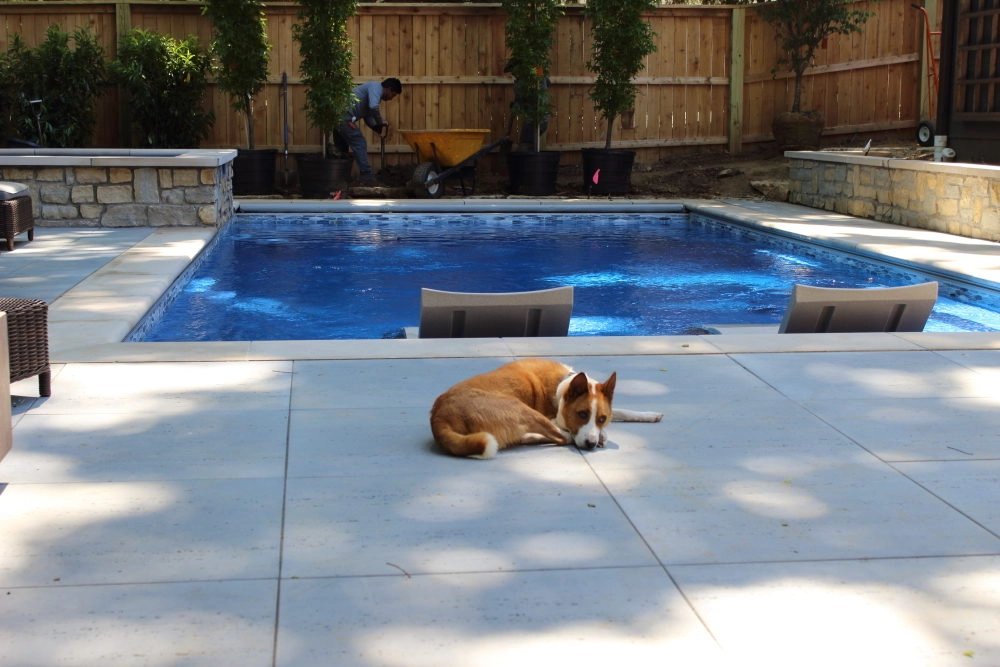
Dogs in Pools: Can My Dog Swim in My Fiberglass Pool?
Introduction: Paws in the Pool – Friend or Foe?
Ever wondered if it is safe to let dogs in pools —for both your pup and your pool? According to the American Pet Products Association, nearly 70% of U.S. households own a pet, and many of those pets are water lovers. For dog owners with backyard pools, this raises a common question: can dogs safely swim in fiberglass pools without damaging them?
Here’s the good news: letting your dog swim in your fiberglass pool might just be the best thing you do for their health—and your happiness.
Many homeowners worry that dogs might ruin the pool surface or disrupt the water chemistry. But with fiberglass, the reality is quite the opposite. Think of your fiberglass pool as a spa retreat for your dog—durable, safe, and built for relaxation.
In this blog, we’ll explore why dogs and fiberglass pools are a match made in backyard paradise. From safety tips and maintenance guidelines to fun poolside activities, we’ll help you create a dog-friendly oasis that keeps tails wagging and water sparkling.
Whether you’re concerned about allowing dogs in pools or curious about how your fiberglass pool holds up, we’ve got you covered.
Is It Safe for Dogs? Why Fiberglass Pools Are Pup-Approved
Understanding Fiberglass Pool Composition
Fiberglass pools are crafted from a single-piece mold using layers of durable, non-porous material. This creates a smooth, seamless surface that’s gentle on paws and resists damage from playful activity.
Unlike concrete pools, which can chip or crack over time, fiberglass is built to withstand wear and tear—even from energetic pups. The smooth surface minimizes abrasions, making it safer for your dog’s footpads during play or swim time.
Safety Advantages Over Other Pool Types
- Vinyl liner pools are particularly vulnerable to damage from dog claws. A single excited leap can tear the liner, leading to costly repairs.
- Concrete pools may be more rugged, but their rough texture can scrape sensitive paws and bellies.
In contrast, fiberglass pools offer a pet-friendly solution that combines durability with comfort, making them a top choice for dog owners.
Impact of Dog Nails on Fiberglass Surfaces
It’s natural to worry about scratches, but here’s the reassuring truth: fiberglass is designed to resist surface damage. Dog nails may leave faint marks over time, especially with frequent use, but these are typically cosmetic and don’t affect the pool’s structural integrity.
Want to go a step further in protecting your investment? Regularly trimming your dog’s nails is a simple yet effective way to preserve the pool’s smooth finish and reduce wear.
Water Chemistry Considerations: Balancing Safety and Cleanliness
Can Dogs Affect Pool Water?
Yes—dogs introduce oils, fur, dander, and bacteria into the pool, roughly equivalent to the impact of three human swimmers per dog. While this doesn’t mean dogs can’t enjoy the water, it does require a bit more attention to water chemistry.
- Test chlorine and pH levels frequently, especially after dog swim sessions.
- Keep sanitizer levels consistent to prevent cloudy water or algae growth.
Saltwater vs. Chlorine Systems
Both saltwater and chlorine systems are safe for dogs when properly maintained. However, saltwater systems tend to be gentler on a dog’s skin, coat, and eyes, making them a popular choice for pet-friendly pools.
Filter Maintenance with Dogs in Swimming Pool
Dog fur and dander can place extra strain on your pool’s filtration system. To keep your pool clean and your equipment running efficiently:
- Invest in a high-capacity or multi-stage filtration system.
- Rinse your dog before swimming to remove loose fur and debris.
Proactive Maintenance Tips
- Clean skimmer baskets daily when dogs swim frequently.
- Backwash filters more often during high-use periods.
- Consider using a pool vacuum or robotic cleaner to manage debris on the floor and walls.
Health Benefits for Dogs: Why Swimming Is a Pawsitive Activity
Swimming isn’t just fun—it’s incredibly good for your dog’s health.
- It provides low-impact, full-body exercise that’s easy on joints, making it ideal for older dogs or those with arthritis.
- Regular swim sessions help manage weight and improve cardiovascular health.
- Mental stimulation from swimming and playing in water reduces anxiety and curbs destructive behaviors in high-energy breeds.
A fiberglass pool offers a safe, controlled environment where your dog can stay active, healthy, and happy.
Precautions to Take Before Letting Dogs in Pools
Training and Supervision
Before your dog becomes a pool pro, it’s important to establish safe habits:
- Train your dog to enter and exit the pool using designated areas like steps or tanning ledges.
- Always supervise your dog during swim time, especially if they’re new to the water or easily fatigued.
Safety Accessories
- Use pet-specific life vests for dogs who are new to swimming or have mobility issues.
- Install ramps or pet-friendly ladders to ensure your dog can exit the pool easily and safely.
Dog-Friendly Features in Fiberglass Pools
Fiberglass pools are customizable, and many features can enhance the swimming experience for your pup:
- Tanning ledges and beach entries provide shallow zones for lounging or gradual entry.
- Splash pads offer a playful option for water-loving dogs who prefer to wade or play rather than swim.
- Non-slip surfaces reduce the risk of slipping and injury when dogs jump in or climb out.
These features not only benefit your dog—they add comfort and style for human swimmers too.
Cleaning and Maintenance After Dog Swimming
Routine maintenance ensures your pool stays clean and inviting, even with regular canine swimmers.
- Brush pool walls and vacuum the floor to remove fur, oils, and other debris.
- Shock the pool weekly to eliminate organic contaminants.
- Use enzyme-based cleaners designed to break down pet-related compounds.
Weekly Maintenance Checklist
- Skim the water surface for fur and debris.
- Test and balance chlorine and pH levels.
- Empty skimmer baskets and clean filters.
- Inspect pool walls and surfaces for buildup or discoloration.
Fun Pool Activities with Your Dog
Water Games to Try
- Fetch with floating toys: Great for exercise and reinforcing recall.
- Obstacle courses: Use pool floats and ramps to create a playful challenge.
- Dock diving: Let energetic breeds leap safely from the pool edge into the water.
Creating a Dog-Friendly Pool Day
- Set up shaded areas with umbrellas or canopies to prevent overheating.
- Provide fresh drinking water to discourage dogs from drinking pool water.
- Dry your dog thoroughly after swimming to avoid ear infections or skin irritation.
Conclusion: Dive into the Joy of Dogs in Pools
Fiberglass pools are a safe, durable, and enjoyable option for dog owners who want to share their love of swimming with their pets. With the right precautions and regular maintenance, your pool can become a shared oasis for you and your furry friend.
From health benefits to joyful bonding moments, letting dogs in pools unlocks a new level of backyard living. When it comes to dogs in pool settings, fiberglass offers the perfect balance of durability, safety, and fun.
Ready to upgrade or add dog-friendly features to your pool? Contact the experts at Integrity Built Pools to get started on your backyard transformation!

